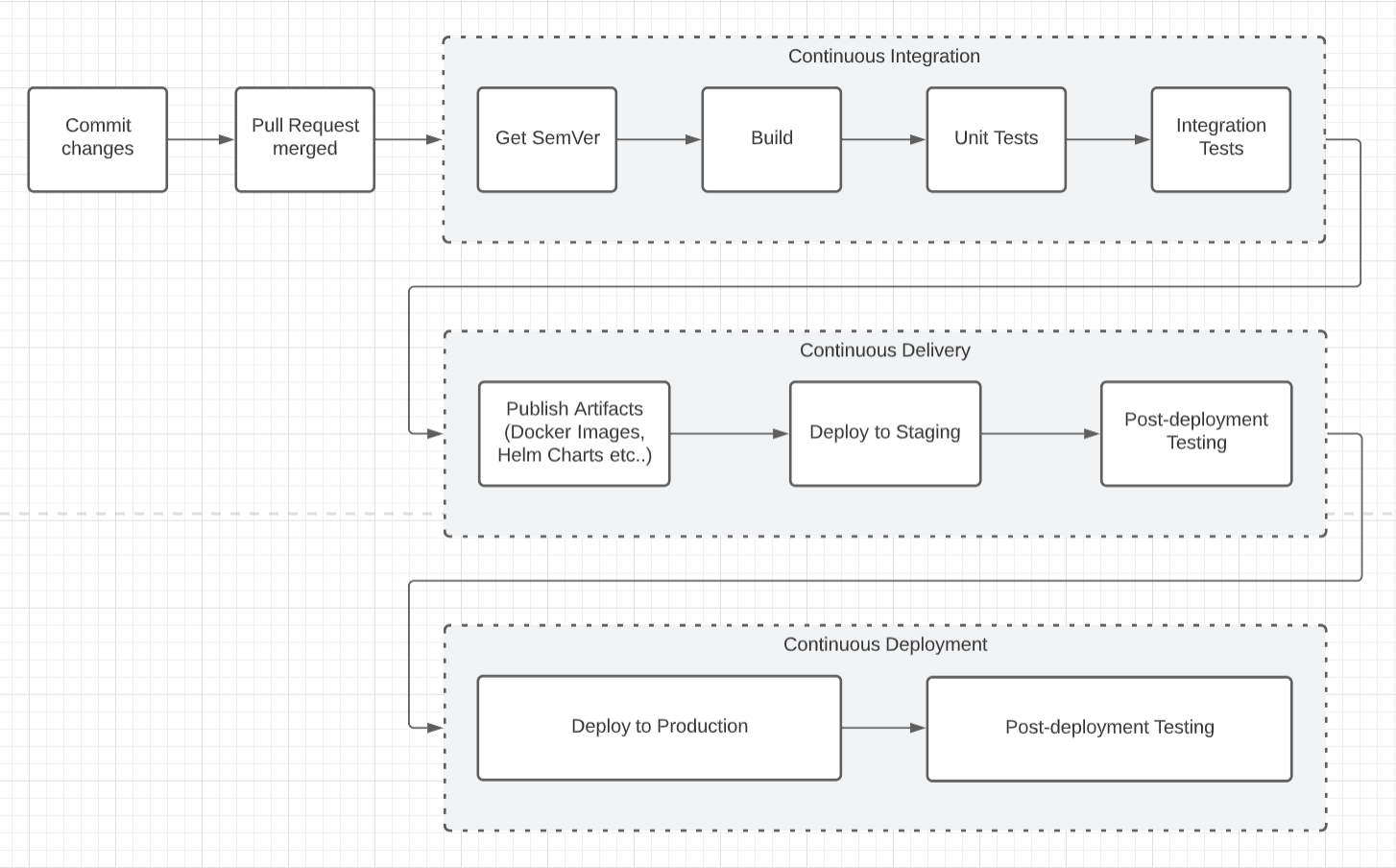Pratik Thanki

Continuous Engineering
11 April 2022Towards a continuous engineering team environment
A huge part of the engineering process is streamlining the journey from code written on a developers machine and production, and by extension, in front of the user. Here, we will touch on several concepts from; Agile, CI/CD/CD and Semantic Versioning and how they all compliment each other in building an engineering culutre and processes to work faster.
Agile
The speed and velocity at which development work is shipped has increased in the last 20 years becuase of advances in technology amongst other reasons. We can see how this also resulted in changes in how teams organise, plan and execute work - i.e. the rising popularity of Kanban as an agile methodology.
Kanban is all about maximizing efficiency (or flow) while limiting work in progress. Team focus is aligned on reducing the time from picking up a story to finishing. This is done using a kanban board and continuously improving flow of work.
Scrum teams commit to completing an increment of work, which is potentially shippable, through set intervals called sprints. The goal is to create feedback loops to quickly gather and integrate customer feedback. Scrum teams adopt specific roles, create release artifacts, and hold regular ceremonies to keep things moving forward.
Continuous Concepts
Further to this, technology has seen the rise in “CI/CD”. The “CI” aspect of that is referred to as continuous integration, which means new code changes are regularly built, tested, and merged to a shared repository as part of an automated pipeline/process. It’s a solution to the all too common problem of having too many branches and defferring conflicts to the end of the development process. Here, think about integration/ regression tests lasting hours and running overnight on a special “release” branch.
While, “CD” can be referred to as continuous delivery and/or continuous deployment. The concepts are related and used interchangeably. Both concepts are about futher automation in the pipeline but mean different things in terms of what is happening. It also is a great demonstration of the degree of automation happening.
Continuous delivery usually means changes to an application are automatically bug tested and that an artifact has been uploaded to a repository (like GitHub or a container registry), where they can be deployed. It’s a means for development to communicate with the business as to what is ready to ship. Based on that logic, the purpose of continuous delivery is to minimise the effort to deploy new code.
Continuous deployment (the other possible “CD”) is where things get very interesting. It is referred to automatically deploying a developer’s changes to production. It addresses the problem of overloading operations teams with manual processes that slow down app delivery. It builds on the benefits of continuous delivery by automating the next stage in the pipeline.
## Semantic Versioning
Anyone who has worked on large-scale projects either microservices or enterprise architectures and things in between one problem teams face is “dependency hell”. In short:
The bigger your system grows and the more packages you integrate into your software, the more likely you are to find yourself, one day, in this pit of despair.
A more in-depth post will follow but in summary the complexity in managing dependencies can cause
issues and result in more effort that could be spent on application development. As such, one of
the most widely used techniques to combat this is the
Semantic Versioning Specification (SemVer) - creating a public API the
version number is detailed as MAJOR.MINOR.PATCH.
Example Implementation
There are many ways to define versions based on the language being used, for instance, in the
.NET ecosystem the MSBuild process can be customised with a Directory.Build.props file.
In this case, we will cover a language agnostic approach. Start-off by defining a Version.xml
in your project directory:
<!--
Given a version number MAJOR.MINOR.PATCH, increment the:
- MAJOR version when you make incompatible API changes,
- MINOR version when you add functionality in a backwards compatible manner, and
- PATCH version when you make backwards compatible bug fixes.
-->
<Project>
<Version>1.0.0</Version>
</Project>
In the CI/CD pipeline the file and version can be accessed with your favourite scriting language. Below is an example with powershell which takes a directory as a command line arguement:
[CmdletBinding()]
param (
[Parameter(Mandatory=$true)] [ValidateNotNullOrEmpty()] [string] $PATH_TO_PROJECT
)
try {
$PATH = Join-Path $PATH_TO_PROJECT 'Version.xml'
[xml]$xmlElement = Get-Content -Path $PATH
$VERSION = $xmlElement.Project.Version
# Sometimes the value needs to be shared with other stages/steps/jobs
# in a pipeline. Some examples below on how to do this:
# GitHub Actions
Write-Host "::set-output name=VERSION::${VERSION}"
# Azure DevOps
# Write-Host "##vso[task.setvariable variable=VERSION;isoutput=true]${VERSION}"
# Team City
# Write-Host "##teamcity[setParameter name='VERSION' value=${VERSION}]"
# Jenkins
# Write-Host VERSION=$VERSION
}
catch {
Write-Error "Error occurred in retrieving Version.."
}
More broadly, when we put the above together - the use of semantic versioning, continuous integration and continuous delivery principles form the foundation of a continuous deployment engineering environment.
The below summarises this point and a depiction of a CI-CD pipeline:

I have a practical example of these principles in action with my own NFL play-by-play API - FourthDown. View runs on GitHub Actions and the configuration - dotnet-core.yml.
If you’ve enjoyed reading this post and would like to learn more about CI/CD, here are some further readings that maybe useful: